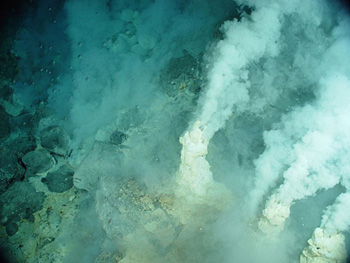
Luca lived beneath the sea

A hydrothermal vent at the Champagne vent site in the Western Pacific.
This week scientists announced a fascinating result regarding the origin of life on Earth. Using come clever genetic detective work, geneticists at the University of Düsseldorf in Germany found evidence that Luca (short for last common universal ancestor, that is, the root of all life) sprang into being at the bottom of the ocean, in so-called hydrothermal vents. These are submarine fissures in the Earth's surface that spew forth water heated up deep inside it.
The team looked at two groups of single-celled species that are still alive today: bacteria and so-called archeae. An obvious first step in profiling Luca is to look for genes that are present in both archeae and bacteria, and that's what the team did, examining 2000 genomes comprising around 6 million genes. There's a hitch, however: common genes don't necessarily come from Luca, but may have transferred from one species to another long after the time Luca was alive. The team therefore looked for genes for which there's no evidence of such lateral gene transfer. They ended up with around 350 genes to consider.
It's those genes that hold the clue to Luca's birth place. They suggest that Luca lived on gases, including hydrogen. The most prevalent source for that are submarine hydrothermal vents. What's more, the distribution of genes identified by the team is also found in modern microbes still living in these strange ecosystems beneath the sea, which are so alien to us.
What's that got to do with maths? Bill Martin, one of the authors of the new study, gave a beautiful interview to BBC Radio 4's Inside Science yesterday. The sentence that stuck in our mind was "There's a lot of computing involved. We had 1000 processors working for about 6 months to calculate [our results]."
Strange creatures live near hydrothermal vents, including this octopus.
That's a heck of a lot of computing! And it reminded us of an article about evolution we recently ran on Plus. The article mentioned phylogenetic trees, which depict genetic relationships between species just like a family tree depicts relations within a family. We made a back-of-the-envelope calculation to figure out the following question: given a number of species how many possible phylogenetic trees are there describing their possible genetic relationships?
The answer gets very big very quickly as the number of species grows. For ten species there are over 34 million possible trees. And for 20 species there are over 8,000,000,000,000,000,000,000 possible trees. That's not that much less than the estimated number of stars in the observable Universe.
We're not sure exactly what kind of calculations Martin in his colleagues did in their six months of computing time — but our calculation illustrates the kind of astronomical numbers geneticists are dealing with. That's why the study of evolution can't do without maths.